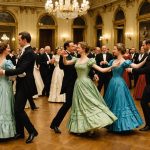Unique Edwardian Ballroom Dancing Events for Tourists
Edwardian ballroom dancing experiences offer a delightful journey back in time, allowing participants to immerse themselves in the elegance of a bygone era. These dance events for tourists not only celebrate the grandeur of historical spaces but also revive the charm and sophistication of traditional historical dances.
Several notable venues across the country host Edwardian ballroom dancing experiences, each adding its own historical flavour to the occasion. These venues, often heritage-listed buildings or grand historic hotels, boast rich histories that enhance the authenticity of the events. Such venues might have been former sites of social gatherings in the Edwardian era, providing a perfect backdrop for attendees to embrace the spirit of the age.
This might interest you : Discover Authentic British Pie Making: Top Workshops for Tourists to Master Traditional Techniques
Special events are frequently organised during peak tourism seasons, drawing enthusiasts and newcomers alike. These occasions often include themed nights, where participants don period-appropriate attire, adding to the overall allure. With live orchestras playing period-accurate music, attendees find themselves transported to a time where the elegance and art of dance reigned supreme.
Whether you’re a dance aficionado or simply curious about historical dances, these events promise a unique cultural experience that seamlessly merges history with entertainment.
Also read : Discover Engaging Workshops on Medieval Herbal Medicine for Tourists: Your Guide to Unique Experiences!
Classes and Workshops in Edwardian Ballroom Dancing
In the world of Edwardian ballroom dancing, a variety of classes cater to different skill levels. These classes are typically divided into beginner, intermediate, and advanced categories, ensuring that each dancer can find a suitable option regardless of their experience level. Beginner classes often focus on the basics, allowing newcomers to grasp fundamental steps and movements, while more experienced dancers may opt for intermediate or advanced sessions that delve into complex routines and techniques.
Dance workshops offer a unique, immersive experience that often goes beyond regular classes. These workshops might involve intensive training sessions that span multiple days, allowing participants to hone their skills under the guidance of seasoned professionals. The advantage of such workshops is the condensed and focused learning opportunity they present, perfect for dancers eager to make swift progress.
The instructors leading these ballroom dancing classes bring a wealth of knowledge and passion to their teaching. Many have extensive backgrounds in dance, with years spent performing and studying various dance forms. From their instructions, students not only learn precise dance moves but also gain an understanding of the cultural and historical context of Edwardian dance, enriching their overall learning experience.
Historical Context of Edwardian Ballroom Dancing
Dance in the Edwardian era was a vivid reflection of social evolution, with ballroom dancing becoming a cultural emblem. This period, spanning from 1901 to 1910, was characterised by a shift towards modernity and saw the emergence of new societal norms. Consequently, the origins of ballroom dancing during this time were heavily influenced by these transitions.
Among the most popular dance styles were the waltz and the tango, which brought fresh dynamism to social gatherings. The waltz, already established, evolved with more intimate and intricate steps, encapsulating the romanticism of the era. Meanwhile, the tango, having seeped into Europe from Argentina, introduced a distinctively passionate flair, challenging previously conservative dance ethics.
The cultural significance of ballroom dancing lay in its embodiment of changing societal values. As society progressed, so too did the dance floor’s openness to more expressive and innovative movements. These dances were not only social activities but also reflected broader cultural shifts, such as the changing roles of women and an increased appreciation for leisure. Thus, tracing Edwardian dance history provides insight into how social and cultural transformations are mirrored in popular pastimes.
Tips for Tourists Attending Dancing Experiences
Embarking on a dancing experience offers tourists a unique glimpse into local culture. To make the most of it, adhering to specific tips can enhance the enjoyment and appreciation of the event.
First, consider what to wear when preparing for dancing events. Comfort is crucial, so choose attire that allows freedom of movement, like lightweight fabrics and shoes with flexible soles. In some cases, formal clothing may be expected, particularly in ballroom dancing, where elegant dresses for women and suits for men are customary.
Understanding etiquette in ballroom dancing is essential. Respect for personal space and courteous behaviour is key. Always thank your dance partners and avoid monopolising their time. If unsure of any moves, watch or ask, rather than improvising.
Familiarise yourself with local customs to enrich your dancing experience further. Each culture may have distinct practices or traditional dances that tourists should observe or partake in. Respect and active participation show sincerity and openness to learning.
Following these tips can transform a simple dance event into a memorable cultural immersion, fostering a deeper connection with the area’s traditions.
Reviews and Testimonials from Participants
Within the world of dance, participant feedback offers invaluable insight into the true magic and challenges of the experience. Delving into a variety of dance experience reviews, vibrant stories emerge, underscoring both the highs and hurdles faced by attendees.
One of the overarching themes in these testimonials is the memorable moments shared during performances and workshops. Participants frequently rave about the joyful communal atmosphere and the unique personal growth realized through dance. “This event reignited my passion for dancing,” claims one participant, capturing a common sentiment. Another highlights the surprise found in overcoming a challenging routine, emphasizing how such experiences foster resilience and creativity.
However, alongside the praises, some reviews surface challenges which further enrich understanding. Common hurdles include mastering complex choreography and synchronizing with fellow dancers, reflecting both the demanding nature of dance and its capacity to drive participants toward excellence. Despite these challenges, attendees often describe these obstacles as rewarding learning experiences.
The incorporation of attendee quotes significantly boosts the credibility of these events. Genuine voices convey authenticity, painting a comprehensive picture of the triumphs and trials encountered by those who embrace the dance.
Practical Details: Schedules, Costs, and Booking Information
Understanding the practical details of booking dancing experiences can significantly enhance your participation in these invigorating events.
The costs of classes can vary broadly depending on factors such as the type of dance, duration, and expertise level. Typically, prices range from £10 for a drop-in session to upwards of £100 for a specialised workshop. Some events might offer discounts or package deals for bulk bookings, so it’s worthwhile to explore these options to make the most of a dance enrichment budget.
To book tickets and reserve your spot, it’s advisable to check dance event websites or popular event platforms. These platforms often provide detailed booking guidance and allow you to choose aspects like time slots and preferred instructors. Early booking is encouraged, especially for high-demand workshops.
Dance event schedules are usually packed with activity options. Hosting multiple sessions within a day or weekend, events can take place on a monthly or even quarterly basis, offering consistent opportunities to indulge in dance. With frequency varying based on the event’s popularity and complexity, enthusiasts should monitor updates and announcements for their favourite activities to maintain their passion throughout the year.
















